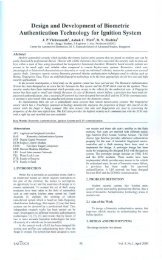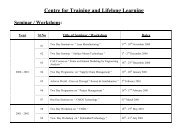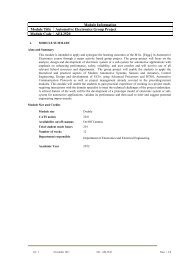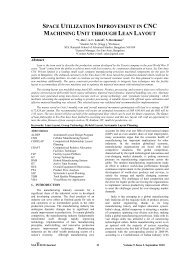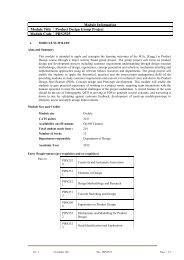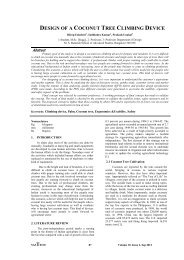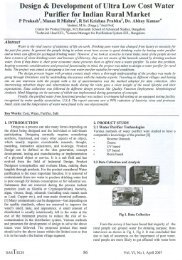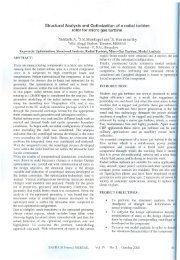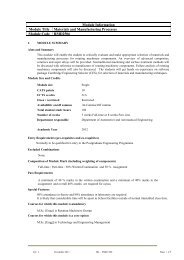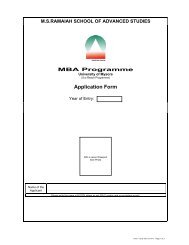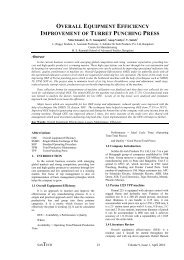A Study on Brand Awareness of Shampoo Products for CavinKare ...
A Study on Brand Awareness of Shampoo Products for CavinKare ...
A Study on Brand Awareness of Shampoo Products for CavinKare ...
You also want an ePaper? Increase the reach of your titles
YUMPU automatically turns print PDFs into web optimized ePapers that Google loves.
A <str<strong>on</strong>g>Study</str<strong>on</strong>g> <strong>on</strong> <strong>Brand</strong> <strong>Awareness</strong> <strong>of</strong> <strong>Shampoo</strong> <strong>Products</strong><br />
<strong>for</strong> <strong>CavinKare</strong> Pvt. Ltd<br />
P. Guru Ragavendran 1 , G. Devakumar 2 , Santhosh Upadhyay 3<br />
1 - MBA (Engg. Operati<strong>on</strong>s) Student, 2 - Pr<strong>of</strong>essor, Department <strong>of</strong> Management Studies,<br />
M.S. Ramaiah School <strong>of</strong> Advanced Studies, Bangalore 560 054<br />
3 - Manager, Market Research, <strong>CavinKare</strong> Pvt. Ltd, Chennai<br />
Abstract<br />
In today’s global market, brand awareness am<strong>on</strong>g c<strong>on</strong>sumers play a decisive role in the sales turnover <strong>of</strong> the<br />
company. Every company invest heavily in this aspect to catch the li<strong>on</strong>’s share <strong>of</strong> the market. <strong>CavinKare</strong> is <strong>on</strong>e <strong>of</strong> such<br />
aspiring Fast Moving C<strong>on</strong>sumer Goods companies in India, with turnover <strong>of</strong> 5000 milli<strong>on</strong> INR in 2006-2007. Although,<br />
<strong>CavinKare</strong> had d<strong>on</strong>e a lot <strong>of</strong> research <strong>on</strong> brand awareness <strong>of</strong> their hair care products, <strong>on</strong>ly a limited research has been<br />
reported <strong>for</strong> its new Chik and Chik Satin shampoo in Bangalore.<br />
In the present work, a study was carried out to estimate the current brand awareness and to suggest methods <strong>for</strong><br />
improving the same. In this process, the socio ec<strong>on</strong>omic stratum <strong>of</strong> women c<strong>on</strong>sumers was identified using socio ec<strong>on</strong>omic<br />
classificati<strong>on</strong> grid during pers<strong>on</strong>al interview at individual households. The data was collected from the target audience <strong>of</strong><br />
18-35 years age at 30 different places in target populati<strong>on</strong> through questi<strong>on</strong>naire. Pareto analysis was used to know the<br />
quality problems <strong>of</strong> major attributes. Quality Functi<strong>on</strong> Deployment was deployed to relate the c<strong>on</strong>sumer voice and<br />
technical descriptors <strong>for</strong> quality improvements in the shampoo brand.<br />
The results revealed that, the major c<strong>on</strong>sumer expectati<strong>on</strong>s were quality, benefits <strong>of</strong>fered and packaging <strong>of</strong> shampoo<br />
product. Based <strong>on</strong> the results obtained, measures were suggested to improve the brand awareness from 8% to 12.6% in<br />
target populati<strong>on</strong>. Suggesti<strong>on</strong> towards improving sales by 45.39% <strong>on</strong> focusing the lagging quality attributes <strong>of</strong> shampoo<br />
has been made.<br />
Key Words: <strong>Brand</strong> Equity, <strong>Brand</strong> <strong>Awareness</strong>, C<strong>on</strong>sumer Behaviour, Quality Functi<strong>on</strong> Deployment<br />
Abbreviati<strong>on</strong>s<br />
FDI Foreign Direct Investment<br />
FMCG Fast Moving C<strong>on</strong>sumer Goods<br />
MNC Multi-Nati<strong>on</strong>al Corporati<strong>on</strong><br />
P&G Procter & Gamble<br />
QFD Quality Functi<strong>on</strong> Deployment<br />
1. INTRODUCTION<br />
To understand better the choice <strong>of</strong> brand from the<br />
c<strong>on</strong>sumers’ perspective it is important to have an idea<br />
<strong>of</strong> the c<strong>on</strong>sumers’ behaviour and their view <strong>of</strong> brands.<br />
There are four types <strong>of</strong> c<strong>on</strong>sumer behaviour: rati<strong>on</strong>al,<br />
unc<strong>on</strong>scious, learned and social behaviour [1]. The<br />
different behaviours are characterized by the order <strong>of</strong><br />
the three steps: knowledge, attitude and acti<strong>on</strong>.<br />
Rati<strong>on</strong>al behaviour: If c<strong>on</strong>sumers have a rati<strong>on</strong>al<br />
behaviour, they start to get some knowledge about the<br />
product and what the market may <strong>of</strong>fer. By evaluating<br />
the in<strong>for</strong>mati<strong>on</strong> they get an attitude towards the product<br />
and finally they act; either buying the product or not.<br />
Unc<strong>on</strong>scious behaviour: When c<strong>on</strong>sumers have an<br />
unc<strong>on</strong>scious behaviour they start with an attitude<br />
towards the product and the attitude comes from<br />
emoti<strong>on</strong>s and feelings. From the attitudes the c<strong>on</strong>sumers<br />
find in<strong>for</strong>mati<strong>on</strong> about the product and from that they<br />
get knowledge. At last they have the acti<strong>on</strong>, their<br />
choice.<br />
Learned behaviour: Reflexes settle the choice <strong>of</strong><br />
product. When the c<strong>on</strong>sumers choose a product they do<br />
not plan their choice; they do it by habit.<br />
Social behaviour: When c<strong>on</strong>sumers have a social<br />
behaviour they choose the products depending <strong>on</strong> what<br />
social envir<strong>on</strong>ment they live in. Their lifestyle, status<br />
and influence from others decide what product they will<br />
buy.<br />
<strong>Brand</strong> equity refers to the marketing effects or<br />
outcomes that accrue to a product with its brand name<br />
compared with those that would accrue if the same<br />
product did not have the brand name. And, at the root <strong>of</strong><br />
these marketing effects is c<strong>on</strong>sumers' knowledge. In<br />
other words, c<strong>on</strong>sumers' knowledge about a brand<br />
makes c<strong>on</strong>sumers resp<strong>on</strong>d differently to the marketing<br />
<strong>of</strong> the brand. The study <strong>of</strong> brand equity is increasingly<br />
popular as some marketing researchers have c<strong>on</strong>cluded<br />
that brands are <strong>on</strong>e <strong>of</strong> the most valuable assets <strong>of</strong> the<br />
company [2].<br />
Fig. 1 <strong>Brand</strong> equity model<br />
<strong>Brand</strong> awareness can be measured by showing a<br />
c<strong>on</strong>sumer the brand and asking whether or not they<br />
knew <strong>of</strong> it be<strong>for</strong>ehand. However, in comm<strong>on</strong> market<br />
research practice a variety <strong>of</strong> recogniti<strong>on</strong> and recall<br />
measures <strong>of</strong> brand awareness are employed all <strong>of</strong> which<br />
test the brand name's associati<strong>on</strong> to a product category<br />
cue. This came about because most market research in<br />
SASTECH 33 Volume 8, Issue 2, September 2009
the 20th Century was c<strong>on</strong>ducted by post or teleph<strong>on</strong>e,<br />
actually showing the brand to c<strong>on</strong>sumers usually<br />
required more expensive face-to-face interviews. This<br />
has led many textbooks to c<strong>on</strong>ceptualize brand<br />
awareness simply as its measures, that is, knowledge<br />
that the brand is a member <strong>of</strong> a particular product<br />
category, e.g. s<strong>of</strong>t-drinks. Examples <strong>of</strong> such measures<br />
include:<br />
• <strong>Brand</strong> recogniti<strong>on</strong> - Either the brand name or both<br />
the brand name and category name are presented to<br />
resp<strong>on</strong>dents.<br />
• <strong>Brand</strong> recall - the product category name is given<br />
to resp<strong>on</strong>dents who are asked to recall as many<br />
brands as possible that are members <strong>of</strong> the<br />
category.<br />
• Top <strong>of</strong> mind brand awareness - as above, but <strong>on</strong>ly<br />
the first brand recalled is recorded.<br />
There has been discussi<strong>on</strong> in industry and practice<br />
about the meaning and value <strong>of</strong> various brand<br />
awareness metrics. Recently, an empirical study<br />
appeared to put this debate to rest by suggesting that all<br />
awareness metrics were systematically related, simply<br />
reflecting their difficulty, in the same way that certain<br />
questi<strong>on</strong>s are more difficult in academic examinati<strong>on</strong>s.<br />
While brand awareness scores tend to be quite stable at<br />
aggregate level, individual c<strong>on</strong>sumers show<br />
c<strong>on</strong>siderable propensity to change their resp<strong>on</strong>ses to<br />
recall based brand awareness measures. For top <strong>of</strong> mind<br />
recall measures, c<strong>on</strong>sumers give the same answer in<br />
two interviews typically <strong>on</strong>ly 50% <strong>of</strong> the time. Similar<br />
low levels <strong>of</strong> c<strong>on</strong>sistency in resp<strong>on</strong>se have been<br />
recorded <strong>for</strong> other cues to elicit brand name resp<strong>on</strong>ses.<br />
<strong>Brand</strong> building deals with name, term, sign,<br />
symbol or design or a combinati<strong>on</strong> <strong>of</strong> all these which is<br />
intended to identify the goods or services <strong>of</strong> <strong>on</strong>e seller<br />
or a group <strong>of</strong> sellers and to differentiate them from<br />
those <strong>of</strong> the competitors. <strong>Brand</strong>-building is very crucial<br />
<strong>for</strong> FMCG companies. The c<strong>on</strong>sumers are reluctant to<br />
try out unknown brands and brand loyalty is fickle.<br />
FMCG blue chips know this tenet which is why they<br />
work relentlessly towards brand-building through highpower<br />
advertising. True, most commercial breaks <strong>on</strong><br />
TV are hogged by FMCG brands. Wooing a c<strong>on</strong>sumer<br />
is an <strong>on</strong>going process and the show must go <strong>on</strong>:<br />
adspend needs to be kept up.<br />
FMCG majors are spending between five and 12<br />
per cent <strong>of</strong> their sales revenue <strong>on</strong> advertising and brand<br />
building. Though average sales <strong>of</strong> most leading MNC’s<br />
and Indian companies in the FMCG industry have<br />
grown in <strong>on</strong>ly single digits over the years, their adspend<br />
have been moving up in double digits.<br />
The marketplace is about to see as many as 1,600<br />
new brands jostling with the existing <strong>on</strong>es <strong>for</strong><br />
occupying the mind-space. And the brand battle is<br />
expected to be fought mostly <strong>on</strong> the televisi<strong>on</strong> screen.<br />
Media inflati<strong>on</strong> will c<strong>on</strong>tinue to be in double digits.<br />
This media inflati<strong>on</strong> is <strong>on</strong>ly <strong>for</strong> holding <strong>on</strong> to the<br />
current mind-space, not to speak <strong>of</strong> increasing the<br />
market shares. Investing in brand-building through<br />
marketing, advertising and promos will hold the key to<br />
success in the FMCG industry [3].<br />
In recent years Indian advertising has also become<br />
more pr<strong>of</strong>essi<strong>on</strong>al. Advertising is now accepted as a<br />
necessity part <strong>of</strong> the marketing mix. This has given<br />
birth to the c<strong>on</strong>cept <strong>of</strong> a ‘Total Plan’, were advertising<br />
combines harm<strong>on</strong>iously with other elements <strong>of</strong> the<br />
marketing mix in order to successfully market a<br />
product. Thus advertising is no l<strong>on</strong>ger looked at in<br />
isolati<strong>on</strong> from other elements <strong>of</strong> the marketing mix.<br />
One <strong>of</strong> the powerful tools to improve brand<br />
awareness is advertising. Advertising creates a twodimensi<strong>on</strong>al<br />
awareness about the brand name and about<br />
the product category. Then there are functi<strong>on</strong>al<br />
advertisements, which talk about the value <strong>of</strong><br />
innovati<strong>on</strong> that has g<strong>on</strong>e into the product.<br />
Advertisements are also used to induce changes in<br />
c<strong>on</strong>sumer behavior. It is not surprising that companies<br />
spend <strong>for</strong>tunes <strong>on</strong> building a brand through high-decibel<br />
advertising.<br />
Indian advertising has underg<strong>on</strong>e many changes<br />
which can be classified into four distinct periods [4].<br />
• Artistic advertising: This phase <strong>of</strong> Indian<br />
advertising c<strong>on</strong>tinued till the mid-sixties. This was<br />
the period <strong>of</strong> sellers market in the country,<br />
competiti<strong>on</strong> was almost n<strong>on</strong>-existent during this<br />
period. Also, the advertisements focused mainly <strong>on</strong><br />
certain product features <strong>on</strong>ly. Advertising during<br />
this period was placid and n<strong>on</strong>-aggressive.<br />
• Sales-oriented advertising: The period <strong>of</strong> midsixties<br />
to mid eighties is characterized as more<br />
aggressive, sales oriented advertising era. There<br />
was marginal shift in advertising t<strong>on</strong>e and<br />
presentati<strong>on</strong> style. Indian market slowly felt<br />
increasing competiti<strong>on</strong> which led advertising to<br />
build up distinct images <strong>for</strong> various brands.<br />
Companies also realised that advertising was a<br />
l<strong>on</strong>g term investment <strong>for</strong> future growth <strong>of</strong> their<br />
portfolio <strong>of</strong> products.<br />
• Sophisticated advertising: This phase started from<br />
the mid <strong>of</strong> eighties. During this period Indian<br />
advertising started focusing <strong>on</strong> emoti<strong>on</strong>al values<br />
and appeals were increasingly used, advertising<br />
became more entertaining and pleasing.<br />
Advertising campaigns were increasingly<br />
coordinated with promoti<strong>on</strong>al mix. So during this<br />
sophisticated advertising each product tries to<br />
create a positi<strong>on</strong> in the c<strong>on</strong>sumers mind and takes<br />
into c<strong>on</strong>siderati<strong>on</strong> not <strong>on</strong>ly product features but<br />
also competitors as well.<br />
• Relati<strong>on</strong>ship building and nature in advertising: In<br />
the 21 st century, there has been a phenomenal<br />
growth in advertising spending. In fact, the growth<br />
<strong>of</strong> advertising has come primarily from the growth<br />
in the c<strong>on</strong>sumer goods sector. In the past it was<br />
comm<strong>on</strong> to look up<strong>on</strong> advertising as a fashi<strong>on</strong><br />
which could cater to the upper strata <strong>of</strong> society.<br />
The reas<strong>on</strong>s <strong>for</strong> this change in attributes are not<br />
difficult to find, the greater choice <strong>of</strong> brands in<br />
many-products like, pers<strong>on</strong>al use fashi<strong>on</strong> or beauty<br />
products, household used food items and durables.<br />
<strong>CavinKare</strong> began with a young mind taking the<br />
road less taken. In 1983 with a single product <strong>of</strong>fering,<br />
<strong>CavinKare</strong> started out as a small partnership firm. More<br />
steps followed and with the innovative Entrepreneur<br />
C.K. Ranganathan at the helm, <strong>CavinKare</strong> emerged into<br />
a successful business enterprise. The company <strong>of</strong>fers<br />
quality hair care, skin care, pers<strong>on</strong>al care, food products<br />
and home essentials, borne out <strong>of</strong> a keen understanding<br />
<strong>of</strong> c<strong>on</strong>sumer needs [5].<br />
<strong>CavinKare</strong> Ltd has pulled the advertising <strong>for</strong> two<br />
<strong>of</strong> its biggest brands, Fairever fairness cream and Nyle<br />
herbal shampoo, from l<strong>on</strong>g-time advertising agency,<br />
Fountainhead Communicati<strong>on</strong>s. Industry sources have<br />
estimated the Fairever account to be worth about Rs 12<br />
SASTECH 34 Volume 8, Issue 2, September 2009
crore, and the Nyle shampoo account to be worth about<br />
Rs 3 crore. According to the company, Fairever has a<br />
more than 12 percent share <strong>of</strong> the Rs 650 crore fairness<br />
cream market, and Nyle ranks as the fifth largest<br />
shampoo brand in the country. <strong>CavinKare</strong> has budgeted<br />
Rs 4 crore <strong>on</strong> televisi<strong>on</strong> commercials to promote the<br />
new Chik Satin over a four-week period [6].<br />
2. PROBLEM DEFINITION<br />
During 1990’s, <strong>CavinKare</strong> launched Chik shampoo<br />
through sachet packets; company has introduced the<br />
sachets at Rs 0.50 which had a tremendous resp<strong>on</strong>se<br />
from urban and rural c<strong>on</strong>sumers, during that time it<br />
captured the major market and acted as m<strong>on</strong>opoly in the<br />
Indian market. After 1995, Hindustan Unilever has<br />
launched its Clinic Plus <strong>for</strong> Rs 0.50 in rural and urban<br />
market. By effective implementati<strong>on</strong> <strong>of</strong> marketing<br />
communicati<strong>on</strong> mix with the help <strong>of</strong> market research<br />
and Foreign Direct Investment [FDI], Unilever Ltd has<br />
attracted major c<strong>on</strong>sumers <strong>of</strong> shampoo towards its<br />
product. Apart from this P&G which is named <strong>for</strong> its<br />
excellent market research strategy implementati<strong>on</strong><br />
process has also created challenges by introducing its<br />
Head&Shoulders and Pantene shampoo at af<strong>for</strong>dable<br />
prices in Indian market. Since the Indian c<strong>on</strong>sumers are<br />
given different opti<strong>on</strong>s in opting different shampoos at<br />
af<strong>for</strong>dable price, which resulted in decline <strong>of</strong> Chik<br />
shampoo users. The c<strong>on</strong>sumers started switching over<br />
from Chik to its competitor products. So in order to<br />
regain its urban market and rural market, <strong>CavinKare</strong> has<br />
launched Chik Satin shampoo with c<strong>on</strong>diti<strong>on</strong>ers <strong>on</strong> 11<br />
September 2008 at a competitive price <strong>for</strong> the target<br />
segment <strong>of</strong> 18-35 years <strong>of</strong> urban women c<strong>on</strong>sumers all<br />
over India [7], [8]. Due to time c<strong>on</strong>straint and in order<br />
to know, whether the brand has reached the c<strong>on</strong>sumers,<br />
this market research <strong>on</strong> brand awareness particularly <strong>for</strong><br />
Chik and Chik Satin shampoo has been c<strong>on</strong>ducted <strong>for</strong><br />
<strong>CavinKare</strong> in Bangalore urban area.<br />
The aim <strong>of</strong> the project is “To study the <strong>Brand</strong><br />
<strong>Awareness</strong> <strong>of</strong> Chik and Chik Satin shampoo <strong>for</strong><br />
<strong>CavinKare</strong> Pvt. Ltd at Bangalore”.<br />
The objectives <strong>of</strong> the study are<br />
1. To carry out the review <strong>of</strong> literature <strong>on</strong> brand, brand<br />
awareness and c<strong>on</strong>sumer behaviour.<br />
2. To study the socio ec<strong>on</strong>omic characteristics <strong>of</strong><br />
women c<strong>on</strong>sumers in Bangalore.<br />
3. To identify the factors influencing brand awareness<br />
<strong>of</strong> Chik and Chik Satin shampoo.<br />
4. To identify and interpret the factors involved in<br />
quality and benefits <strong>of</strong>fered in the shampoo product.<br />
5. To know the impact <strong>of</strong> brand awareness in sales<br />
improvement <strong>of</strong> the shampoo product.<br />
Methodology: Literature survey has been carried out<br />
using research journals, books and websites. Socio<br />
ec<strong>on</strong>omic stratum <strong>of</strong> women c<strong>on</strong>sumers have been<br />
identified using socio ec<strong>on</strong>omic classificati<strong>on</strong> grid<br />
during pers<strong>on</strong>al interview at individual households.<br />
Factors influencing brand awareness <strong>of</strong> shampoo<br />
products have been analyzed with the data collected<br />
from questi<strong>on</strong>naire. Comparative study has been carried<br />
out based <strong>on</strong> advertisement awareness with the<br />
competitor. Pareto analyses have been used to identify<br />
the major quality problems in the shampoo product.<br />
Comparative study has been carried out to know the<br />
existing and lagging quality attributes in the shampoo<br />
product with the competitor. Quality Functi<strong>on</strong><br />
Deployment has been deployed to distinguish the<br />
relati<strong>on</strong>ship between c<strong>on</strong>sumer voice and technical<br />
descriptors. The impact <strong>of</strong> brand awareness <strong>on</strong> sales<br />
improvement has been analyzed by applying the<br />
existing awareness and usage ratio in target populati<strong>on</strong>.<br />
Tools and Techniques: The Pareto Principle states<br />
that <strong>on</strong>ly a "vital few" factors are resp<strong>on</strong>sible <strong>for</strong><br />
producing most <strong>of</strong> the problems. This principle can be<br />
applied to quality improvement to the extent that a great<br />
majority <strong>of</strong> problems 80% are produced by a few key<br />
causes 20%. If we correct these few key causes, we will<br />
have a greater probability <strong>of</strong> success. Pareto analysis is<br />
applied to know the maximum quality requirements <strong>of</strong><br />
the c<strong>on</strong>sumers.<br />
Quality Functi<strong>on</strong> Deployment (QFD) methodology<br />
is used to translate customer needs and requirements<br />
into the quality characteristics to improve quality <strong>for</strong> an<br />
existing product to develop a new c<strong>on</strong>sumer product<br />
[9]. Here quality functi<strong>on</strong> deployment is deployed in<br />
order to know the quality problems in Chik, Clinic Plus<br />
and Sunsilk shampoos.<br />
3. ANALYSIS AND INTERPRETATION<br />
3.1 Analysis <strong>on</strong> Televisi<strong>on</strong> Advertisements<br />
<strong>CavinKare</strong>’s Sp<strong>on</strong>sorship Program at<br />
Doordarshan: Indian media industry has shown<br />
excellent growth both in numbers and in reach.<br />
Table 1 shows the changing trends in India’s<br />
media spectrum.<br />
Table 1 Changing trends in India’s media spectrum<br />
Source: [4]<br />
Media Means 1993 2006<br />
TV Channels 17 300+<br />
Press Publicati<strong>on</strong>s 303 400+<br />
Radio / FM Stati<strong>on</strong>s 90 275+<br />
Cinema Theatres 7692 9650+<br />
From the above table, it can be inferred that during<br />
1993 there are <strong>on</strong>ly selected televisi<strong>on</strong> channels <strong>for</strong><br />
entertainment, am<strong>on</strong>g them Doordarshan was <strong>on</strong>e and<br />
c<strong>on</strong>sumers had no other opti<strong>on</strong> <strong>for</strong> their entertainment.<br />
But after 2006, there are more than 300 commercial<br />
channels in India; c<strong>on</strong>sumers have different choices <strong>for</strong><br />
their entertainment means<br />
Percentage <strong>of</strong> brand awareness improvement through<br />
televisi<strong>on</strong> advertisement during prime time:<br />
Televisi<strong>on</strong> Media & Effectives <strong>on</strong> <strong>Brand</strong> [11]<br />
Ad Frequency [Prime Time] = 3<br />
Impact = 1<br />
Providing 3 Frequency <strong>of</strong> Ads during Prime Time<br />
[(1/3) (4, 34,391) (4.6/100) (3)] = 19,982<br />
Percentage <strong>of</strong> <strong>Awareness</strong><br />
Target Populati<strong>on</strong> = 4, 34,391<br />
After Ad <strong>Awareness</strong> = 19,982<br />
Percentage<br />
(19982/434391) (100) = 4.6%<br />
If 3 frequencies <strong>of</strong> advertisements are given during<br />
prime time per day, the brand awareness increases by<br />
4.6% in target populati<strong>on</strong>.<br />
SASTECH 35 Volume 8, Issue 2, September 2009
Perceived Purchase Value<br />
Total <strong>Brand</strong> <strong>Awareness</strong> and number <strong>of</strong> Chik shampoo<br />
users from sample size <strong>of</strong> 300<br />
Total brand awareness <strong>of</strong> Chik =22<br />
(Number <strong>of</strong> resp<strong>on</strong>dents)<br />
Current users <strong>of</strong> Chik =18<br />
Source: <strong>Brand</strong> <strong>Awareness</strong> Survey Data [From ‘Oct 08’<br />
To ‘Dec 08’]<br />
<strong>Awareness</strong> to Usage ratio [22:18] = (18/22) (19,982)<br />
Perceived Purchase = 26,349 pers<strong>on</strong>s<br />
Source: <strong>Brand</strong> <strong>Awareness</strong> Survey Data [From ‘Oct 08’<br />
To ‘Dec 08’]<br />
Table 2 Most viewed televisi<strong>on</strong> programme<br />
during prime time in Bangalore<br />
Bangalore - Channel wise top day part<br />
Channels Time Band Programs<br />
CHAK DE<br />
Net<br />
Reach<br />
(%)<br />
9X 19:30 20:00 BACHCHE<br />
BALIKA<br />
1.2<br />
colors 20:00 20:30 VADHU 10.9<br />
NDTVlm 20:30 21:00 JYOTHI<br />
WOH REHNE<br />
2.7<br />
Sahara<br />
WAALI<br />
One 21:00 21:30 MEHLON KI<br />
HUM<br />
2.3<br />
S<strong>on</strong>y 20:30 21:00 LADKIYAN 1.5<br />
Star One 21:30 22:00 SHAKUNTALA 2.1<br />
Star Plus 21:00 21:30 BIDAAI<br />
CHHOTI<br />
9.6<br />
Zee TV 19:30 20:00 BAHU<br />
MUKTHA<br />
9.2<br />
ETV 21:30 22:00 MUKTHA 4.6<br />
MAA TV 16:00 20:00 MOVIE TIME 0.5<br />
Sun TV<br />
Source: [10]<br />
21:00 21:30 KOLANGAL 0.7<br />
Cost <strong>for</strong> advertising in televisi<strong>on</strong> during prime time<br />
Regi<strong>on</strong>al Channel<br />
In ETV the cost <strong>for</strong> advertising <strong>for</strong> 30 Sec<strong>on</strong>ds during<br />
Prime Time = Rs 3, 80,000<br />
Calculating cost per sachet: Cost per sachet have been<br />
calculated by using the mean value <strong>of</strong> shampoo usage<br />
from women resp<strong>on</strong>dents, which is then applied to<br />
perceived purchase after advertisement awareness. The<br />
total c<strong>on</strong>sumpti<strong>on</strong> per weak has been identified by<br />
multiplying frequency <strong>of</strong> shampoo usage per weak and<br />
c<strong>on</strong>tent <strong>of</strong> <strong>on</strong>e sachet. Since 3% <strong>of</strong> the resp<strong>on</strong>dents are<br />
price sensitive, from total c<strong>on</strong>sumpti<strong>on</strong> the 3% has been<br />
reduced. For calculating per sachet cost, total televisi<strong>on</strong><br />
cost has been divided by total c<strong>on</strong>sumpti<strong>on</strong>.<br />
Per week usage:<br />
<strong>Shampoo</strong> [Mean Value] = 2.26 [average usage per<br />
week]<br />
Milli Litre [ml] = 7 per sachet<br />
Total c<strong>on</strong>sumpti<strong>on</strong> per week = [(2.26) (7)]<br />
= 15.82<br />
Source: <strong>Brand</strong> <strong>Awareness</strong> Survey Data [From ‘Oct 08’<br />
To ‘Dec 08’]<br />
Per week c<strong>on</strong>sumpti<strong>on</strong><br />
(In sachets) = 2.26<br />
Target populati<strong>on</strong> = [(18/22) (19982)]<br />
= 16349<br />
Source: <strong>Brand</strong> <strong>Awareness</strong> Survey Data [From ‘Oct 08’<br />
To ‘Dec 08’]<br />
Total c<strong>on</strong>sumpti<strong>on</strong> in sachet = [(2.26) (16349)]<br />
= 36949<br />
Increase <strong>of</strong> cost per sachet:<br />
Sales from sample = [(62, 00,000) (18/300) (2.26)]<br />
= 840720<br />
C<strong>on</strong>sumer usage after the<br />
influence <strong>of</strong> ads = 36949<br />
Total c<strong>on</strong>sumpti<strong>on</strong> [In sachets] = (840720+36949)<br />
= 877669<br />
From Survey: Only (3%) <strong>of</strong><br />
Resp<strong>on</strong>dents are price sensitive = [(877669) (3/100)]<br />
= 26330<br />
Net c<strong>on</strong>sumpti<strong>on</strong> per week<br />
[In Sachets] = (877669-26330)<br />
= 8, 51,339<br />
Advertisement cost per day = Rs. 11, 40,000<br />
Per packet ad Cost = (11, 40,000 / 8, 51,339)<br />
Advertisement cost <strong>on</strong><br />
Per sachet = Rs. 1.33<br />
Existing price <strong>of</strong> sachet = Rs. 0.50<br />
= Rs. 0.50 + Rs 1.33<br />
Price including advertising cost = Rs. 1.83<br />
Discount price <strong>for</strong><br />
[Wholesalers, Distributors<br />
and Retailers] = Rs. 0.17<br />
= Rs. 1.83 + Rs. 0.17<br />
Total price <strong>of</strong> per sachet = Rs. 2.00<br />
The price per sachet has been increased to Rs. 2.00<br />
after including the advertisement cost in the sachets <strong>for</strong><br />
urban market.<br />
3.2 Comparing Clinic Plus, Chik Satin and<br />
Chik<br />
Table 3 Recall factors in Clinic Plus shampoo<br />
SI.No Recall No. <strong>of</strong> % <strong>of</strong><br />
Factors Resp<strong>on</strong>dents Resp<strong>on</strong>dents<br />
1 Mother and<br />
Daughter<br />
29 60%<br />
2 Whole family 6 12%<br />
3 Presentati<strong>on</strong><br />
is good<br />
4 8%<br />
Table 4 Recall factors in Chik Satin and Chik<br />
shampoo<br />
SI.No Recall<br />
Factors<br />
1 Mother and<br />
Daughter<br />
2 Loose and<br />
Free Hair<br />
3 Smooth and<br />
silky hair<br />
No. <strong>of</strong> % <strong>of</strong><br />
Resp<strong>on</strong>dents Resp<strong>on</strong>dents<br />
1 2%<br />
5 10%<br />
3 6%<br />
(From Tables 3 and 4) it can be inferred that<br />
percent <strong>of</strong> recall factors in clinic plus is more compared<br />
with Chik and Chik Satin. The reas<strong>on</strong> behind this is in<br />
clinic plus the whole family is shown in the<br />
advertisement. In Indian culture the family is very<br />
SASTECH 36 Volume 8, Issue 2, September 2009
important. <strong>Brand</strong>s that support family values tend to be<br />
popular. C<strong>on</strong>sumer care and affecti<strong>on</strong> are values that<br />
the Indian c<strong>on</strong>sumer rates much higher than <strong>for</strong><br />
ambiti<strong>on</strong> and achievement. So the company should<br />
focus <strong>on</strong> sensitivity <strong>of</strong> c<strong>on</strong>sumers.<br />
Fig. 2 Percentage <strong>of</strong> recall factors in Chik, Chik<br />
Satin and Clinic Plus shampoo<br />
4. STRONG RECALL FACTORS IN<br />
ADVERTISEMENTS<br />
Table 5 Str<strong>on</strong>g recall factors in<br />
advertisements<br />
SI. Advertisements Recall % <strong>of</strong><br />
No<br />
Factors Resp<strong>on</strong>dents<br />
1 Vodaf<strong>on</strong>e Small<br />
Dog<br />
15<br />
2 Johns<strong>on</strong> & Johns<strong>on</strong> Baby 13<br />
3 Surf Excel Kids 4<br />
4.1 Advertisement Avoidance<br />
Table 6 Advertisement avoidance<br />
SI.No Advertisements No. <strong>of</strong><br />
Resp<strong>on</strong>dents<br />
watching<br />
Ads<br />
No. <strong>of</strong><br />
Resp<strong>on</strong>dents<br />
not<br />
watching<br />
Ads<br />
1 B-Class 81 19<br />
2 C-Class 86 14<br />
3 D-Class 89 11<br />
4 Total (Average) 85% 15%<br />
From Table 5 it can be inferred that the<br />
resp<strong>on</strong>dents like more emoti<strong>on</strong>al and sensitivity recall<br />
factors in advertisements while watching televisi<strong>on</strong>. In<br />
the advertisement 15% <strong>of</strong> resp<strong>on</strong>dents recalled<br />
Vodaf<strong>on</strong>e <strong>for</strong> its small dog during the pers<strong>on</strong>al<br />
interview, Johns<strong>on</strong> & Johns<strong>on</strong> was recalled <strong>for</strong> its baby<br />
shown in the advertisements and Surf Excel was<br />
recalled <strong>for</strong> the kids shown in the advertisements. So it<br />
was recommended to provide str<strong>on</strong>g recall and<br />
emoti<strong>on</strong>al factors during advertisements.<br />
From Table 6 it can be inferred that around 15<br />
percent <strong>of</strong> target c<strong>on</strong>sumers are not interested in<br />
watching advertisements during the commercial breaks.<br />
It was very clear that the c<strong>on</strong>tent <strong>of</strong> the advertisement<br />
was the most important criteria <strong>for</strong> the pers<strong>on</strong> to judge<br />
whether they wanted to see the advertisement or not.<br />
This is reflected in high percentage <strong>for</strong> poor quality <strong>of</strong><br />
advertisement as stated reas<strong>on</strong>s <strong>for</strong> ad avoidance.<br />
Currently it appears that c<strong>on</strong>sumers are neither<br />
receiving expected in<strong>for</strong>mati<strong>on</strong> value nor the<br />
entertainment value. Findings also show that the<br />
viewers do generally not prefer the l<strong>on</strong>ger durati<strong>on</strong> ads<br />
because the required in<strong>for</strong>mati<strong>on</strong> may get distorted or<br />
diluted [12].<br />
Innovative Advertisement Executi<strong>on</strong> Format: There are<br />
four types <strong>of</strong> innovative advertisement executi<strong>on</strong> <strong>for</strong>mat<br />
[4].<br />
Fig. 3 Product use and benefits<br />
Advertisement in Figure 3 represents the product<br />
use and benefits <strong>of</strong> the shampoo product.<br />
Fig. 4 Slice <strong>of</strong> life<br />
Advertisement in Figure 4 represents providing soluti<strong>on</strong><br />
<strong>for</strong> hair care problem<br />
Fig. 5 Associati<strong>on</strong><br />
SASTECH 37 Volume 8, Issue 2, September 2009
Advertisement in Figure 5 represents the c<strong>on</strong>sumer<br />
percepti<strong>on</strong> <strong>on</strong> shampoo product with use and benefits <strong>of</strong><br />
the product.<br />
Fig. 6 Testim<strong>on</strong>ials<br />
Advertisement in Figure 6 represents the testim<strong>on</strong>ials<br />
with brand celebrity.<br />
4.2 Analysis <strong>on</strong> Quality and Benefits Offered<br />
Pareto analysis: The Pareto Principle states that <strong>on</strong>ly a<br />
"vital few" factors are resp<strong>on</strong>sible <strong>for</strong> producing most<br />
<strong>of</strong> the problems. This principle can be applied to quality<br />
improvement to the extent that a great majority <strong>of</strong><br />
problems say 80%, are produced by a few key causes<br />
like 20%. If we correct these few key causes, we will<br />
have a greater probability <strong>of</strong> success. So the Pareto<br />
analysis is applied to know the quality requirements <strong>of</strong><br />
the c<strong>on</strong>sumers.<br />
Table 7 C<strong>on</strong>sumer expectati<strong>on</strong> attributes<br />
Attributes<br />
Total<br />
number <strong>of</strong><br />
c<strong>on</strong>sumers<br />
Percentage (%)<br />
Avoid hair loss<br />
Prevent<br />
47 15.67<br />
Dandruff 35 11.67<br />
Suitable <strong>for</strong> hair 30 10.00<br />
S<strong>of</strong>tens hair 29 9.67<br />
Hair growth 28 9.33<br />
Fragrance 26 8.67<br />
Naturalness 26 8.67<br />
No rough hair 19 6.33<br />
Less Chemicals 18 6.00<br />
Vitamins 15 5.00<br />
Price 11 3.67<br />
C<strong>on</strong>diti<strong>on</strong>ers 6 2.00<br />
Others<br />
To remove oil<br />
5 1.67<br />
dirt 4 1.33<br />
Easy to rinse 1 0.33<br />
Grand Total 300 100.00<br />
Comparing c<strong>on</strong>sumer expectati<strong>on</strong> with Chik and<br />
its competitors: To know the existing and lagging<br />
attributes in shampoo product a comparative analysis<br />
has been d<strong>on</strong>e by comparing Chik and its competitors<br />
with the c<strong>on</strong>sumer expectati<strong>on</strong> attributes. Sales weight<br />
points have been c<strong>on</strong>sidered <strong>for</strong> corresp<strong>on</strong>ding quality<br />
and benefits attributes to determine their impact in<br />
sales.<br />
Table 7 explains the priority <strong>of</strong> c<strong>on</strong>sumer<br />
requirements in the quality and benefit attributes <strong>of</strong><br />
shampoo. Here the attributes are c<strong>on</strong>verted to 100% to<br />
compare with Chik shampoo.<br />
Fig. 7 <strong>Brand</strong> equity model<br />
Table 8 Existing and lagging attributes in Chik<br />
Attributes<br />
% <strong>of</strong><br />
c<strong>on</strong>sumer<br />
requirements<br />
Chik % Lagging<br />
Suitable <strong>for</strong> hair 10.00 4.35 5.65<br />
Avoid hair loss 15.67 13.04 2.62<br />
C<strong>on</strong>diti<strong>on</strong>ers 2.00 0.00 2.00<br />
Easy to rinse 0.33 0.00 0.33<br />
Fragrance 8.67 0.00 8.67<br />
Hair growth 9.33 8.70 0.64<br />
Less Chemicals 6.00 4.35 1.65<br />
Naturalness 8.67 4.35 4.32<br />
No rough hair 6.33 8.70 -2.36<br />
Others 1.67 0.00 1.67<br />
Prevent<br />
Dandruff 11.67 8.70 2.97<br />
Price 3.67 8.70 -5.03<br />
S<strong>of</strong>tens hair 9.67 34.78 -25.12<br />
To remove oil<br />
dirt 1.33 4.35 -3.01<br />
Vitamins 5.00 0.00 5.00<br />
Grand Total 100.00 100.00<br />
Comparis<strong>on</strong> has been d<strong>on</strong>e in (table 8) <strong>for</strong> the<br />
attributes <strong>of</strong> Chik with c<strong>on</strong>sumer expectati<strong>on</strong> in order to<br />
know the existing and lagging attributes <strong>of</strong> Chik<br />
shampoo.<br />
To know the impact <strong>of</strong> quality improvements in<br />
increase <strong>of</strong> sales percentage, all the lagging attributes<br />
are multiplied with their corresp<strong>on</strong>ding sales weight<br />
provided by the company. The sales weights <strong>for</strong><br />
corresp<strong>on</strong>ding attributes are listed in Table 9.<br />
Table 10 shows 45.39% <strong>of</strong> sales improvement can<br />
be made by improving the lagging attributes <strong>of</strong> Chik<br />
shampoo.<br />
Quality Functi<strong>on</strong> Deployment – Relati<strong>on</strong>ship<br />
Matrix: Customer competitive evaluati<strong>on</strong>s: Customer<br />
competitive evaluati<strong>on</strong> prepares a competitive or<br />
strategic assessment <strong>of</strong> the business. This plan brings<br />
out the firm’s competitive weaknesses, strength and<br />
identifying areas needing quality improvement.<br />
Determine the technical requirements: In this<br />
stage, customer demands were translated into technical<br />
requirements. The objective is to translate each<br />
SASTECH 38 Volume 8, Issue 2, September 2009
customer voice into <strong>on</strong>e or more technical requirements.<br />
Here “what” questi<strong>on</strong> by identifying customers’<br />
requirements and “how” questi<strong>on</strong> by identifying the<br />
measurable and definable design features <strong>of</strong> the<br />
c<strong>on</strong>sumer product. In this study, eight important quality<br />
characteristics were c<strong>on</strong>sidered to meet customer<br />
requirements. These are per<strong>for</strong>mance, features,<br />
reliability, c<strong>on</strong><strong>for</strong>mance, durability, serviceability,<br />
aesthetics, and quality.<br />
Table 9 Attributes with corresp<strong>on</strong>ding sales<br />
weight<br />
Attributes<br />
Total<br />
number <strong>of</strong><br />
c<strong>on</strong>sumers<br />
% <strong>of</strong><br />
c<strong>on</strong>sumer<br />
requirements<br />
Sales<br />
Weight<br />
Avoid hair loss 47 15.67 1.5<br />
Prevent<br />
Dandruff 35 11.67 1.5<br />
Suitable <strong>for</strong> hair 30 10.00 1.5<br />
S<strong>of</strong>tens hair 29 9.67 1.5<br />
Hair growth 28 9.33 1.5<br />
Fragrance 26 8.67 1.2<br />
Naturalness 26 8.67 1.2<br />
No rough hair 19 6.33 1.2<br />
Less Chemicals 18 6.00 1.2<br />
Vitamins 15 5.00 1.2<br />
Price 11 3.67 1<br />
C<strong>on</strong>diti<strong>on</strong>ers 6 2.00 1<br />
Others 5 1.67 1<br />
To remove oil<br />
dirt 4 1.33 1<br />
Easy to rinse 1 0.33 1<br />
Grand Total 300 100.00<br />
Table 10 Percentage <strong>of</strong> sales improvement in<br />
Chik<br />
Attributes<br />
Chik<br />
Lagging<br />
(%)<br />
Sales<br />
Weights<br />
Sales<br />
(%)<br />
Suitable <strong>for</strong> hair 5.65 1.5 8.48<br />
Avoid hair loss 2.62 1.5 3.93<br />
C<strong>on</strong>diti<strong>on</strong>ers 2.00 1 2.00<br />
Easy to rinse 0.33 1 0.33<br />
Fragrance 8.67 1.2 10.40<br />
Hair growth 0.64 1.5 0.96<br />
Less Chemicals 1.65 1.2 1.98<br />
Naturalness 4.32 1.2 5.18<br />
Others 1.67 1 1.67<br />
Prevent Dandruff 2.97 1.5 4.46<br />
Vitamins 5.00 1.2 6.00<br />
Total 35.52 45.39<br />
• Per<strong>for</strong>mance refers to the primary operating<br />
characteristics <strong>of</strong> the product or service. They are<br />
usually measurable. For a shampoo these<br />
characteristics would include the cleanliness factor<br />
such as, easy to foam or easy to rinse.<br />
• Features are additi<strong>on</strong>al characteristics that enhance<br />
the product/service appeal to the user. Adding<br />
c<strong>on</strong>diti<strong>on</strong>er to the shampoo can be given as an<br />
example; brightness <strong>for</strong> normal hair or extra<br />
vitamins is being added to feed hair.<br />
• Reliability <strong>of</strong> a product is the likelihood that a<br />
product will not fail within a specific time period.<br />
This is the key element <strong>for</strong> users who need the<br />
product to work without fail.<br />
• C<strong>on</strong><strong>for</strong>mance is precisi<strong>on</strong> with which the product<br />
or service meets the specified standards.<br />
• Durability measures the length <strong>of</strong> a product’s life.<br />
For shampoo, it measures how l<strong>on</strong>g the shampoo<br />
will keep its effectiveness <strong>of</strong> <strong>for</strong>mula.<br />
• Serviceability is the speed with which the product<br />
can be put into service when it breaks down, as<br />
well as the competence and behavior <strong>of</strong> the<br />
servicepers<strong>on</strong>.<br />
• Aesthetics is the subjective dimensi<strong>on</strong> indicating<br />
the kind <strong>of</strong> resp<strong>on</strong>se a user has to a product. It<br />
represents the individual’s pers<strong>on</strong>al preferences. It<br />
reflects the ways <strong>of</strong> individual’s resp<strong>on</strong>se to the<br />
look, feel and smell. A pers<strong>on</strong> judging the smell <strong>of</strong><br />
a shampoo would say it is <strong>of</strong> higher quality.<br />
Relati<strong>on</strong>ship matrix between hows and whats: After<br />
establishing the “whats” and “hows”, c<strong>on</strong>structi<strong>on</strong> <strong>of</strong><br />
house <strong>of</strong> quality c<strong>on</strong>tinues with establishing the<br />
relati<strong>on</strong>ships between the customer voices and the<br />
technical requirements. To build the relati<strong>on</strong>ship matrix<br />
between “hows” and “whats”, it is necessary to<br />
establish if relati<strong>on</strong>ships exist between every what and<br />
every how. All relati<strong>on</strong>ships are categorized such as<br />
either str<strong>on</strong>g, medium, or weak. A score <strong>of</strong> 9 is used to<br />
indicate a str<strong>on</strong>g relati<strong>on</strong>ship between whats and hows.<br />
A score <strong>of</strong> 3 signifies a moderate relati<strong>on</strong>ship and a<br />
square <strong>of</strong> 1 signifies a weak relati<strong>on</strong>ship between them.<br />
The matrix in (figure 8) shows all relati<strong>on</strong>ship between<br />
customer requirements and technical requirements.<br />
Quality plan: After calculating column weights, it can<br />
be seen which particular technical requirements are<br />
important to improve first, so that ef<strong>for</strong>t could be<br />
c<strong>on</strong>centrated <strong>on</strong> them <strong>for</strong> quality improvement study. In<br />
this case, c<strong>on</strong><strong>for</strong>mance was determined to be the most<br />
important technical requirement. As it is explained<br />
earlier, c<strong>on</strong><strong>for</strong>mance is defined as meeting the specified<br />
standards. For the fast moving c<strong>on</strong>sumer goods,<br />
c<strong>on</strong>sumer can have many alternative products <strong>for</strong> their<br />
preferences, there<strong>for</strong>e in order to satisfy the customer,<br />
company should meet at least required standards.<br />
5. CONCLUSION<br />
The survey helped in understanding the c<strong>on</strong>sumer<br />
percepti<strong>on</strong> <strong>on</strong> brand awareness and positi<strong>on</strong> <strong>of</strong> product<br />
in the market. It was observed that c<strong>on</strong>sumer’s<br />
expectati<strong>on</strong>s were, Quality, benefits <strong>of</strong>fered and<br />
packaging <strong>of</strong> shampoo product. Based <strong>on</strong> the results<br />
obtained, integrated marketing communicati<strong>on</strong> was<br />
suggested, as a result an improvement <strong>of</strong> 8% to 12.6%<br />
was observed in target populati<strong>on</strong>. Lagging quality<br />
attributes have been identified <strong>for</strong> the improvement <strong>of</strong><br />
sales by 45.39%. Suggesti<strong>on</strong>s towards improving brand<br />
awareness through quality attributes have been made.<br />
REFERENCES<br />
[1] Jay D. Lindquist M. and Joseph Sirgy, (2007)<br />
Shopper, Buyer and C<strong>on</strong>sumer Behavior- Theory<br />
and Marketing Applicati<strong>on</strong>s, New Delhi: Biztantra,<br />
p. 285-289.<br />
SASTECH 39 Volume 8, Issue 2, September 2009
[2] David A. Aaker, Rajeev Batra, John G. Myers,<br />
(2006) Advertising Management, New Delhi:<br />
Eastern Ec<strong>on</strong>omy Editi<strong>on</strong>, p. 316-324.<br />
[3] An<strong>on</strong>ymous, Adspend in FMCG Advertisements,<br />
Retrieved 12/16/2008 from<br />
http://www.financialexpress.com/old/fe/daily/2000<br />
0619/ffe13080.html<br />
[4] Ramanuj Majumdar (2008), Product Management<br />
in India, New Delhi: Eastern Ec<strong>on</strong>omy Editi<strong>on</strong>, p.<br />
278-286.<br />
[5] An<strong>on</strong>ymous, <strong>CavinKare</strong> Company Pr<strong>of</strong>ile,<br />
Retrieved 12/14/2008 from<br />
http://www.cavinkare.com/corprate.asp<br />
[6] An<strong>on</strong>ymous, <strong>CavinKare</strong> Investment in Advertising,<br />
Retrieved 12/19/2008 from<br />
http://www.hindu.com/businessline/2000/06/0<br />
2/stories/190202nn.htm<br />
[7] Saeed, M. Ravinder Vinayek and Narender Kumar,<br />
(2008) Rebranding: An Emerging <strong>Brand</strong> Market<br />
Strategy (Trends, Issues and Challenges, Indian J.<br />
<strong>of</strong> Marketing, pp. 3-11.<br />
Fig. 8 Quality functi<strong>on</strong> deployment<br />
[8] Disha Mahajan, Navneeta Agarwal and Anand<br />
Agarwal, (2008) “Evoluti<strong>on</strong> <strong>of</strong> Market<br />
Segmentati<strong>on</strong>”, The Icfai J. <strong>of</strong> Marketing<br />
Management, 7(2), pp. 30-38.<br />
[9] Dale Besterfield, Carol Besterfield, Glen<br />
Besterfield and Mary Besterfield, (2007) Total<br />
Quality Management, New Delhi: Prentice Hall<br />
India, p. 334-357.<br />
[10] An<strong>on</strong>ymous, “Net reach <strong>of</strong> Channels” Retrieved<br />
01/22/2009 from<br />
http://www.audiencemap.com/yesterday.htm<br />
[11] Philip Kotler, Kevin Lane Keller, (2006)<br />
Marketing Management, New Delhi: Pears<strong>on</strong><br />
Educati<strong>on</strong>, p. 165-175.<br />
Sandip Anand, (2008) Ad Avoidance inHair Care<br />
Market: Reiterati<strong>on</strong> <strong>of</strong> Need <strong>for</strong> C<strong>on</strong>sumer Justice,<br />
Indian J. <strong>of</strong> Marketing, pp. 44-47.<br />
SASTECH 40 Volume 8, Issue 2, September 2009



